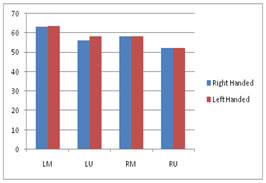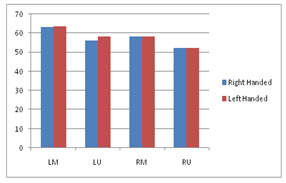Official Journals By StatPerson Publication
|
Table of Content - Volume 11 Issue2 - August 2019
Study of correlation between hand dominance and nerve conduction velocity
Ruth Joshi1, Nitin Joshi2*
1,2Professor, Department of Physiology, Smt. Kashibai Navale Medical College, Pune, Maharashtra, INDIA. Email: nbjoshi125@gmail.com
Abstract Background: Cerebral dominance in terms of speech, handedness, facial recognition and thinking is a known fact. The nerve conduction parameter studies are used to diagnose disorders of the peripheral nervous system. Nerve Conduction Velocity is the speed with which the electrical impulses are transmitted along the peripheral nerve fibres and across synapses, involving no cognitive activity. Handedness and nerve conduction velocity is not studied much hence this study was undertaken with the aim to compare handedness with peripheral nerve conduction velocity. Aims and Objectives: To find correlation between the hand dominance and variation in nerve conduction velocities Material and Methods: The study included 100 adult males in the age group of 25 to 40 years. Out of which 25 were left handed and 75 were right handed. All the participants were examined through RMS nerve conduction machine by using standard techniques of supra-maximal per cutaneous stimulation with a constant current stimulator and surface electrodes recording for nerves of both sides of each subject Results: Sensory nerve conduction velocities in left handed individuals for median and ulnar nerves of both the sides were higher compared to right handed individuals. But this difference was significant only for left ulnar nerve (p =0.0001) Motor nerve conduction velocities in left handed individuals were also higher compared to right handed individuals. But this difference was not statistically significant Conclusion: sensory nerve conduction velocities are higher in left handers which could be because of genetic reasons contributing to functional physiological differences during growth in early childhood. Key Word: Nerve Conduction Velocity, Cerebral Dominance, Right & Left side.
INTRODUCTION Cerebral dominance in terms of speech, handedness, facial recognition and thinking is a known fact. Upper Limb dominance or handedness is a more precise preference for use of one hand. The hand which preferred is known as the dominant hand and the less preferred hand is called the non-dominant hand. Left hand dominance is slightly more in men than women. Right dominance is the most common form and accounts for 90% of the world’s population1,2,3,4.Left-brained person often said to be more logical, analytical, and objective whereas right-brained are said to be more intuitive, thoughtful and subjective. There are theories proposed for explaining handedness. Its Occurrence during prenatal development period is important. Researchers have studied fetuses in utero and determined that dominance detected in the womb is a good predictor after birth5.The nerve conduction parameter studies are used to diagnose disorders of the peripheral nervous system. Nerve Conduction Velocity is the speed with which the electrical impulses are transmitted along the peripheral nerve fibres and across synapses, involving no cognitive activity. The known factors affecting nerve conduction velocity (NCV) are age, temperature, height, gender, fibre diameter, degree of myelination and inter-nodal distance4,5,6. Nerve conduction velocities are specific to each individual and depends largely on an diameter and the degree of myelination of axon, but the majority of individuals fall within the defined normal ranges7Various cerebral functions like speech, language, analysis of face, recognition of musical themes, fine motor movements have also been studied along with Nerve conduction velocity (NCV) with dominance. A disproportionately large number of artists, musicians and mathematicians are left handed Hence the spatial talents of left handed persons may be well above average. Learning disabilities like dyslexia are 12 times more common in left handed persons than in right handed persons hence variations in nerve conduction velocity with handedness is also expected8.Researchers have discovered already that specific alleles of at least one of three single polynucleotide polymorphism upstream of the LRRTM gene were linked to left-dominance. This gene may be responsible for the difference in nerve conduction9 Dominance and nerve conduction velocity is not studied much hence this study was undertaken with the aim to compare handedness with peripheral nerve conduction velocity.MATERIAL AND METHODApproval of institutional ethics committee was taken prior to commencement of this study. The study was conducted in the Department of Physiology of our institute. The study included 100 adult males in the age group of 25 to 40 years. Out of which 25 were left handed and 75 were right handed. Handedness was defined on the basis of use of hand for dexterity or strength. Written informed consent and preliminary details with complete history of the subjects were taken. Subjects with Peripheral nerve injury, metabolic disorders, fracture, deformity, radiculopathy, nerve compression and other neurological disorders were excluded from study. The subject were properly instructed and motivated to provide full cooperation. All the participants were examined through RMS nerve conduction machine. Nerve conduction properties were evaluated by using standard techniques of supra-maximal per cutaneous stimulation with a constant current stimulator and surface electrodes recording for nerves of both sides of each subject. The room temperature of the laboratory was attained at thermo neutral zone i.e 26+/- 2 degree Celsius. Nerve Conduction Velocity (NCV) of median and ulnar nerves on both the sides were recorded.OBSERVATIONS & RESULTSA total of 100 subjects (25 left handers and 75 right handers) were included in the study. The mean age (in years) was 34 in left handers and 33 in right handers. There was no significant difference in the age in the two groups (p = 0.474).Comparison of nerve conduction velocity: Sensory nerve conduction velocities (in meters per second) in left handed individuals for median and ulnar nerves of both the sides were higher compared to right handed individuals. But this difference was significant only for left ulnar nerve (p =0.0001) (Table-1, Graph-1).Table 1
Table 2
Graph 1 Graph 2 DISCUSSIONThe subjects of the age group of 25to 40 years with left handedness (n=25) and right handedness (n=75) were selected for nerve conduction velocity study. The study was carried out in a laboratory at constant temperature to eliminate variations relatedto temperature. In this study nerve conduction velocity for sensory nerves and motor nerves of the upper limbs were found higher in left handed individuals compared to right handed but statistically significant result were found only for ulnar nerve for sensory nerve conduction study. These may be because of genetic reasons and contribute to functional differences during growth in early childhood. Repetitive low- intensity exercise results inenhanced aerobic capacity, fatigue resistance and contractile slowing of the muscle. Long-term preferential use of selected muscles can be viewed as a moderate form of exercise. In the past decade, several researchers reported differences in physiology between the dominant and the non-dominant upper limb10.Asymmetry of sensory nerve conduction velocity was also detected by Bromberg et al11. Similar results were also reported byGupta et al12,Tayade et al6 and Soumya BA et al13. Our study also showed that there is no significant difference in motor conduction velocity though the velocities were on higher side in left handers. Symmetry of motor conduction velocity was also confirmed by Bromberg et al11. Some study reported different results like Pardaman Singh et al and Seema Bhorania et al14 who showed greater velocity in median nerve of right handers compared to left handers. The study concludes that the sensory nerve conduction velocities are higher in left handers which could be because of genetic reasons contributing to functional physiological differences during growth in early childhood. This difference should be eliminated before commenting on any neurological diagnosis in left handers.
REFERENCES
|
|
|||||||||||||||||||||||||||||||||||||||||||||
 Home
Home


